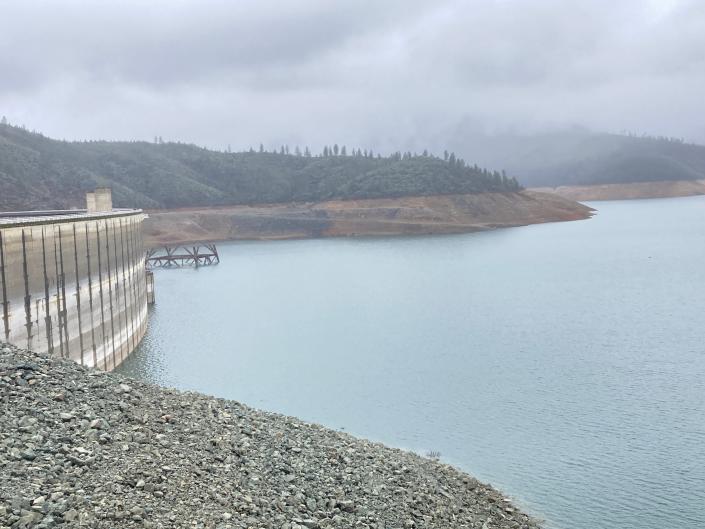While all the rain that fell in December helped raise the level of a parched-looking Lake Shasta, the series of winter storms failed to generate the massive inflows of water into the state’s largest reservoir.
That’s expected to change over the next 10 days as a series of wet storms moves through the region, dropping several inches of rain, which has prompted the National Weather Service to issue a flood watch for Wednesday and Thursday in Shasta County.
“This next system that moves through is going to hit Shasta hard,” Don Bader, area manager of the U.S. Bureau of Reclamation, said Tuesday morning. “We’re probably looking at 40 or 50 feet of the lake coming up.”
The Bureau of Reclamation operates Lake Shasta and Trinity Lake. The two reservoirs hold water that is used to supply numerous local water agencies, including the cities of Redding and Shasta Lake, Bella Vista Water District and other smaller water districts in the Redding area.
As of Tuesday, Lake Shasta was 34% full and 57% of normal for this time of year.
Trinity Lake, which also supplies water to Whiskeytown Lake and the Sacramento River, was 38% of normal, according to the California Department of Water Resources.
Bader said Lake Shasta rose about 10 feet in December.
The big winner from December’s wet weather was Folsom Lake outside of Sacramento, which was nearly two-thirds full and 148% of average as of Tuesday.
“The American River is a pretty big basin and Folsom is not really a big reservoir, so it was coming up a foot an hour” at times, Bader said.
He said drainage into Folsom was at about 100,000 cubic feet per second, while Lake Shasta “barely got 15,000 to 20,000″ cfs.

“This next system we are going to see that quadruple in a day. That’s why the big increase in Shasta,” Bader said. “We can fill this thing up in the winter. Shasta can be full, but it has to keep raining.”
Which didn’t happen last year.
After a wet fall and early winter, the rain stopped in January, February and March.
“December, January and February are key months for precipitation. We gotta have it because we get into spring and it’s just not the big winter events we like to see,” Bader said.
“It’s encouraging. At least through mid-January, we certainly have some good storm events,” he added.
Meanwhile, the Department of Water Resources conducted its first snow survey Tuesday, which showed the statewide snowpack 174% of average for the date.
Despite the encouraging numbers, state water officials said relief from the prolonged drought will depend on the coming months.
And while snow in the mountains also is welcome sight, Bader reiterated that for Lake Shasta, it’s rain that matters — 90% of the water that fills the reservoir each year comes from rain.
“What killed us the last two years is that it was so damn dry, all the water and snow that comes into the tributaries, went right into the ground,” Bader said. “These December rains got it wet and primed and now most of the runoff (will go) into the lake.”
This article originally appeared on Redding Record Searchlight: California storms: Lake Shasta water level to rise 40 to 50 feet
